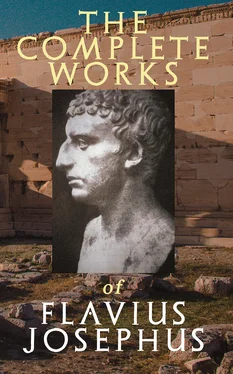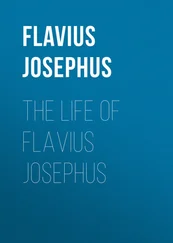Now for the works that were above these foundations, these were not unworthy of such foundations; for all the cloisters were double, and the pillars to them belonging were twenty-five cubits in height, and supported the cloisters. These pillars were of one entire stone each of them, and that stone was white marble; and the roofs were adorned with cedar, curiously graven. The natural magnificence, and excellent polish, and the harmony of the joints in these cloisters, afforded a prospect that was very remarkable; nor was it on the outside adorned with any work of the painter or engraver. The cloisters (of the outmost court) were in breadth thirty cubits, while the entire compass of it was by measure six furlongs, including the tower of Antonia; those entire courts that were exposed to the air were laid with stones of all sorts. When you go through these first cloisters, unto the second court of the temple, there was a partition made of stone all round, whose height was three cubits: its construction was very elegant; upon it stood pillars, at equal distances from one another, declaring the law of purity, some in Greek, and some in Roman letters, that "no foreigner should go within that sanctuary" for that second court of the temple was called "the Sanctuary," and was ascended to by fourteen steps from the first court. This court was four-square, and had a wall about it peculiar to itself; the height of its buildings, although it were on the outside forty cubits, 2was hidden by the steps, and on the inside that height was but twenty-five cubits; for it being built over against a higher part of the hill with steps, it was no further to be entirely discerned within, being covered by the hill itself. Beyond these thirteen steps there was the distance of ten cubits; this was all plain; whence there were other steps, each of five cubits a-piece, that led to the gates, which gates on the north and south sides were eight, on each of those sides four, and of necessity two on the east. For since there was a partition built for the women on that side, as the proper place wherein they were to worship, there was a necessity for a second gate for them: this gate was cut out of its wall, over against the first gate. There was also on the other sides one southern and one northern gate, through which was a passage into the court of the women; for as to the other gates, the women were not allowed to pass through them; nor when they went through their own gate could they go beyond their own wall. This place was allotted to the women of our own country, and of other countries, provided they were of the same nation, and that equally. The western part of this court had no gate at all, but the wall was built entire on that side. But then the cloisters which were betwixt the gates extended from the wall inward, before the chambers; for they were supported by very fine and large pillars. These cloisters were single, and, excepting their magnitude, were no way inferior to those of the lower court.
Now nine of these gates were on every side covered over with gold and silver, as were the jambs of their doors and their lintels; but there was one gate that was without the inward court of the holy house, which was of Corinthian brass, and greatly excelled those that were only covered over with silver and gold. Each gate had two doors, whose height was severally thirty cubits, and their breadth fifteen. However, they had large spaces within of thirty cubits, and had on each side rooms, and those, both in breadth and in length, built like towers, and their height was above forty cubits. Two pillars did also support these rooms, and were in circumference twelve cubits. Now the magnitudes of the other gates were equal one to another; but that over the Corinthian gate, which opened on the east over against the gate of the holy house itself, was much larger; for its height was fifty cubits; and its doors were forty cubits; and it was adorned after a most costly manner, as having much richer and thicker plates of silver and gold upon them than the other. These nine gates had that silver and gold poured upon them by Alexander, the father of Tiberius. Now there were fifteen steps, which led away from the wall of the court of the women to this greater gate; whereas those that led thither from the other gates were five steps shorter.
As to the holy house itself, which was placed in the midst of the inmost court, that most sacred part of the temple, it was ascended to by twelve steps; and in front its height and its breadth were equal, and each a hundred cubits, though it was behind forty cubits narrower; for on its front it had what may be styled shoulders on each side, that passed twenty cubits further. Its first gate was seventy cubits high, and twenty-five cubits broad; but this gate had no doors; for it represented the universal visibility of heaven, and that it cannot be excluded from any place. Its front was covered with gold all over, and through it the first part of the house, that was more inward, did all of it appear; which, as it was very large, so did all the parts about the more inward gate appear to shine to those that saw them; but then, as the entire house was divided into two parts within, it was only the first part of it that was open to our view. Its height extended all along to ninety cubits in height, and its length was fifty cubits, and its breadth twenty. But that gate which was at this end of the first part of the house was, as we have already observed, all over covered with gold, as was its whole wall about it; it had also golden vines above it, from which clusters of grapes hung as tall as a man's height. But then this house, as it was divided into two parts, the inner part was lower than the appearance of the outer, and had golden doors of fifty-five cubits altitude, and sixteen in breadth; but before these doors there was a veil of equal largeness with the doors. It was a Babylonian curtain, embroidered with blue, and fine linen, and scarlet, and purple, and of a contexture that was truly wonderful. Nor was this mixture of colors without its mystical interpretation, but was a kind of image of the universe; for by the scarlet there seemed to be enigmatically signified fire, by the fine flax the earth, by the blue the air, and by the purple the sea; two of them having their colors the foundation of this resemblance; but the fine flax and the purple have their own origin for that foundation, the earth producing the one, and the sea the other. This curtain had also embroidered upon it all that was mystical in the heavens, excepting that of the twelve signs, representing living creatures.
When any persons entered into the temple, its floor received them. This part of the temple therefore was in height sixty cubits, and its length the same; whereas its breadth was but twenty cubits: but still that sixty cubits in length was divided again, and the first part of it was cut off at forty cubits, and had in it three things that were very wonderful and famous among all mankind, the candlestick, the table of shew-bread, and the altar of incense. Now the seven lamps signified the seven planets; for so many there were springing out of the candlestick. Now the twelve loaves that were upon the table signified the circle of the zodiac and the year; but the altar of incense, by its thirteen kinds of sweet-smelling spices with which the sea replenished it, signified that God is the possessor of all things that are both in the uninhabitable and habitable parts of the earth, and that they are all to be dedicated to his use. But the inmost part of the temple of all was of twenty cubits. This was also separated from the outer part by a veil. In this there was nothing at all. It was inaccessible and inviolable, and not to be seen by any; and was called the Holy of Holies. Now, about the sides of the lower part of the temple, there were little houses, with passages out of one into another; there were a great many of them, and they were of three stories high; there were also entrances on each side into them from the gate of the temple. But the superior part of the temple had no such little houses any further, because the temple was there narrower, and forty cubits higher, and of a smaller body than the lower parts of it. Thus we collect that the whole height, including the sixty cubits from the floor, amounted to a hundred cubits.
Читать дальше












